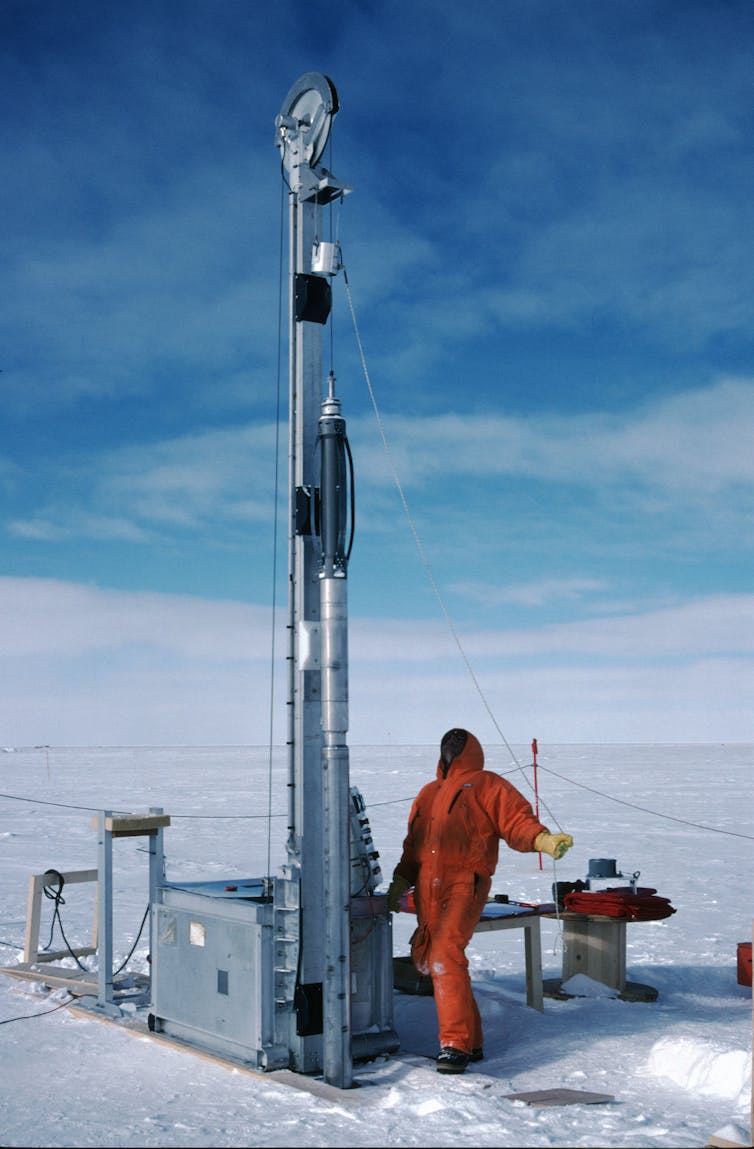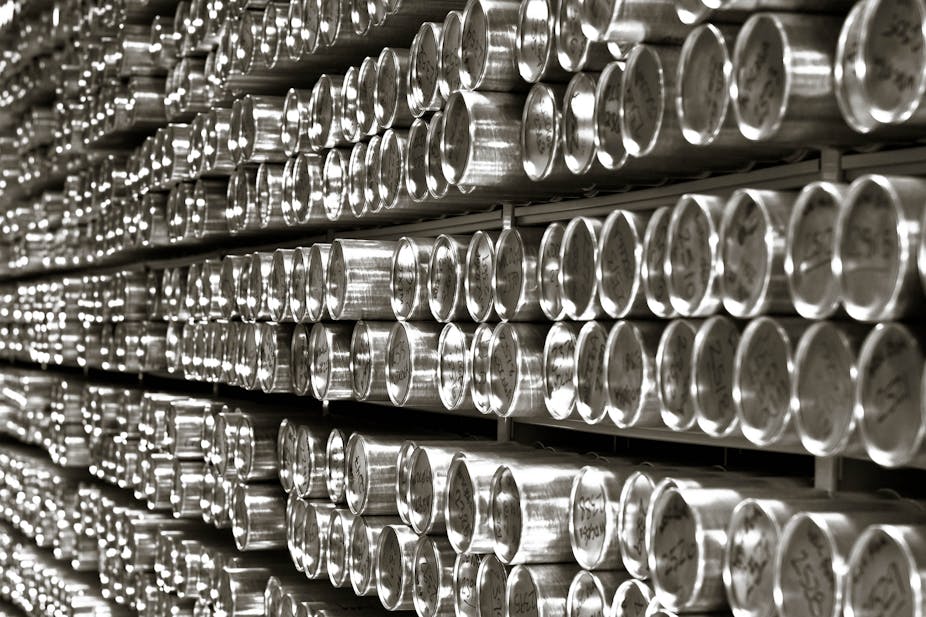Ice cores are cylinders of ice drilled from glaciers and ice sheets. When snow falls it takes with it a record of many aspects of the atmosphere. As long as no melting takes place, this information is preserved as each layer of snow is buried by successive snowfalls from year to year. By drilling into the ice sheet, we can recover a chronological archive of the atmosphere.
Most ice cores are recovered from the Greenland and Antarctic ice sheets. However, it is also possible to obtain cores from glaciers at high altitudes at lower latitudes for example, in the Alps, Andes and Himalaya mountains. In the two large polar ice sheets, the ice may be more than 3000m deep.
Cores are recovered using drills that collect typically 3m of ice at a time, in a cylinder often 10cm in diameter. The drill is on the end of a cable: it is lowered to the depth of the previous collection, where it grips the side of the hole so that an inner section, with drill teeth on the lower end, can rotate. The teeth cut a ring of chippings, so that a cylinder of ice fills the inside of the drill barrel. This is then taken to the surface.

Because ice deforms under pressure, the hole has to be filled with an inert fluid that keeps it from closing. The ice cores are then kept cold, in insulated boxes inside freezers, while they are transported from Greenland and Antarctica to laboratories of universities and research institutes for analysis.
Analysing the ice
The ice can be dated by various methods – in favourable cases it is possible to find a chemical whose concentration varies from summer to winter, so that each year can be counted. However often more complex methods are used to determine the age. The oldest ice recovered in an ice core so far is 800,000 years in Antarctica and 128,000 years in Greenland.
The ice can be analysed for its physical properties (such as electrical conductivity), and sections are melted for chemical analysis. Information is held in three forms:
The water molecules of the ice itself are not all the same – they come in various isotopic forms. The ratio between the different isotopes is used to determine the temperature at the time the snow fell.
Various chemicals are trapped with the snow at the surface of the ice sheet. For example, after large volcanic eruptions, sulfuric acid is deposited from the atmosphere and shows up in ice cores as clear spikes in sulfate concentration against a relatively flat background.
As the layers of snow are buried the individual crystals of snow eventually (at somewhere between 60 and 100m deep) join together to form a solid matrix of ice with air bubbles trapped inside. These air bubbles contain a sample of all the stable gases in the air from the time that it compacted including nitrogen, oxygen and argon. They can be cracked open for analysis.

Unlocking knowledge of the past
Ice cores are a very important source of information about the past. They are the main archive of information about temperature and snowfall rates in the polar regions, as well as our only direct record of atmospheric composition before the middle of the 20th century.
Numerous chemicals can be measured that give information about the extent of past sea ice, volcanic activity, the strength of the sun, winds and many other environmental parameters. Information from ice cores is then complemented by other palaeoclimate archives such as marine sediments, corals, tree rings and speleothems (mineral deposits that form in caves such as stalactites).
Numerous major scientific findings have emerged from ice cores. Carbon dioxide concentrations were fairly steady at around 280 parts per million in the millenium before 1800, but have risen to nearly 400 parts per million since then. This reveals the extent that industrialisation has added CO2 to the atmosphere, and clarifies how unusual recent changes are compared to the small and slow natural variations throughout history.
At a much longer timescale, Antarctic ice cores have shown that temperatures there, like many other climate signals, varied between warm interglacial periods and cold “ice ages” roughly every 100,000 years. Carbon dioxide concentrations in the ice tracked faithfully with the temperature changes. The CO2 increases at the end of each cold period helped to amplify small regional changes in climate into the large global changes that led Earth into and out of ice ages.
Ice cores therefore play an important role in adding to our understanding of the Earth’s climate through the ages and help us confirm and map how the climate has evolved. Unfortunately they don’t give much of a forecast for the future, however, because the ice core era does not contain concentrations of CO2 comparable to now and the future.

